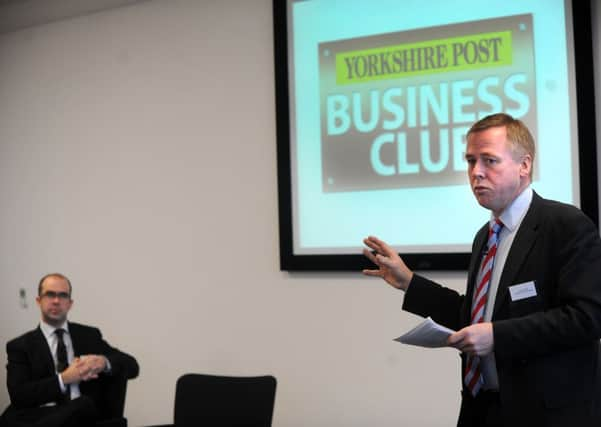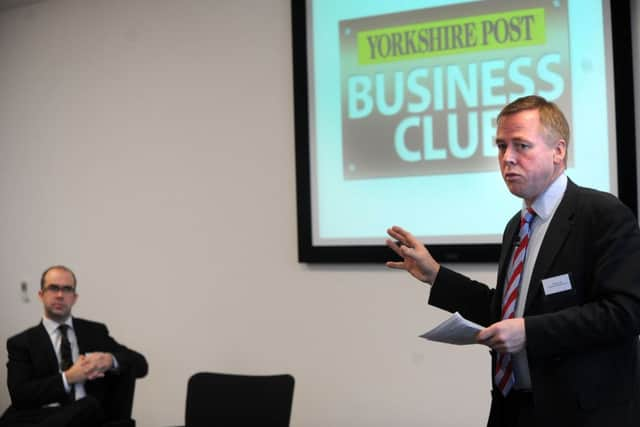Video: Skipton chief in housing bubble warning


David Cutter, who is also chairman of the Building Societies Association, said affordability was the key to whether rising house prices were sustainable.
Speaking at the Yorkshire Post Business Club yesterday, he said his prediction was higher than that of the Office for Budget Responsibility, which forecast a 5.2 per cent rise next year.
Advertisement
Hide AdAdvertisement
Hide Ad“The big unknown is how the people who are borrowing money, which is helping to push up house prices, will cope in a rising interest rate environment,” he said.


He added: “The concern is looking out into 2015/16/17 at a time when the authorities have an incredibly difficult job to try and extricate the market from these exceptional circumstances.
“There is £375bn of quantitative easing and the impact that has in terms of bond rates, the FLS (Funding for Lending Scheme), the two Help to Buy schemes and then fundamentally low interest rates.
“How do they take the lending community – banks, companies, and households – off that life support machine?
Advertisement
Hide AdAdvertisement
Hide Ad“It’s not going to be easy and I’m sure there will be some unintended consequences. To me, that is where the big unknown is. Not in next year or the year after but in 2016/17/18.”
Mr Cutter was speaking to an audience of housing executives and entrepreneurs at the Business Club, a forum for debate and discussion for the region’s business leaders.
He spoke about how the nation “has moved from the language of ‘mortgage famine’ to ‘house price bubbles’ in the space of a year”.
According to mortgage lender Halifax, house prices rose at their fastest pace in more than six years in November at 1.1 per cent.
Advertisement
Hide AdAdvertisement
Hide AdAverage house prices in the three months to November were 7.7 per cent higher than a year earlier, although the average house price remains 12 per cent below a peak in August 2007.
Mr Cutter said: “The important thing to stress is that it’s very regional. When you talk about average UK house prices, there is enormous diversity.”
Skipton, Britain’s fourth largest building society, operates about one per cent of the residential mortgage market, lending £2.25bn a year.
It also owns the country’s third largest estate agency Connells, which has 485 branches across the country and trades under a number of well-known brands including William H Brown.
Advertisement
Hide AdAdvertisement
Hide AdThe rise in house prices has been fuelled by a number of Government-backed programmes including two Help to Buy schemes and the Funding for Lending Scheme.
Mr Cutter said the second Help to Buy scheme, designed to help first-time buyers, was “clearly very political” but it had had an impact on the market.
Net lending over the last four years has remained flat at £9bn but this year the figure is expected to rise by £10bn.
In June, the number of 95 per cent mortgage products available was 58. Last month, the figure had risen to 161.
Advertisement
Hide AdAdvertisement
Hide Ad“Life has been breathed back into the housing market and the mortgage market,” Mr Cutter said.
Simon Usher, director in charge of housebuilder Persimmon Homes Yorkshire, also spoke at the event.
He said: “Generally, the message is the good times are here but we don’t want them to be too good. We want steady growth.”
Mr Usher said supply was not keeping up with current demand for housing and was unlikely to do so for quite some time.
Advertisement
Hide AdAdvertisement
Hide AdThere were 22.1 million households in the UK in 2011 and the number is rising by 220,000 each year. But only 100,000 new houses have been built in 2013. Mr Usher said there would be a knock-on effect on prices.
“But we want stability at Persimmon, not rapid price increases,” he said. “Slow and steady is the way forward.”
Peter Hill, chief executive of Leeds Building Society, who was in the audience, said the shortage of skills across the house building industry needed to be urgently addressed.
In reply, Mr Usher said bricklayers saw a 40 per cent wage increase this year to address the issue.
Advertisement
Hide AdAdvertisement
Hide Ad“Last time the market was like this, everybody (skilled foreign workers) flooded in and it helped the supply side,” he said. “This time it hasn’t happened.”
Planning objections are another barrier to new housing developments, Mr Usher added. “Nobody wants new schemes building near them,”
The Government’s overhaul of the planning system has opened the way for developers to target greenfield land instead of brownfield sites, according to the Local Government Select Committee.
News: Page 4